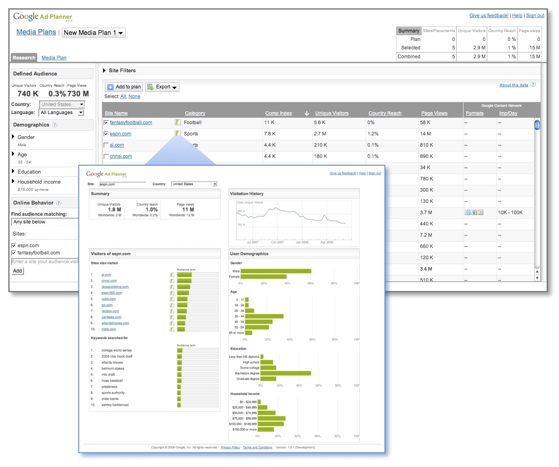
The recent launch of Google Trends for Websites was just a dress rehearsal. The real product that it is based on is Google Ad Planner, which the company announced today. Google Ad Planner is built for ad buyers who want to decide where to place their ads. It provides general traffic and demographic information for Websites, including gender, age, education, and household income.
One drawback of Google Ad Planner is that you cannot actually buy ads from inside it, not even Google ads. Advertisers have to log in separately to their AdWords or other ad platform accounts to do that.
But the bigger issue around both Google Ad planner and Trends for Websites is where exactly Google is getting this data from. The traffic data in Googel Ad Planner appears to be the same thing consumers can see on Google Trends for Websites. In fact, that is just a light version of Google Ad Planner, which uses some of the same underlying data—”aggregated Google search data, opt-in anonymous Google Analytics data, opt-in external consumer panel data, and other third-party market research.” If that sounds kind of vague it is because it is.
The unanswered question is whether Google is using its widely deployed toolbar to collect the traffic data that it now wants advertisers to use for targeting ads. Danny Sullivan at SearchEngineLand, who has a good review, specifically asked Google if it was using toolbar data as well. Google responded saying it would “not disclose the elements of our secret sauce” even though it disclosed some of the other elements above (search data, Google Analytics data, panel data, etc.). Sullivan concludes:
It’s noteworthy the Google Toolbar isn’t being mentioned. I specifically asked to have confirmation that the toolbar is NOT in the mix, and “secret sauce” reply above is all I got.
That makes me think that toolbar data IS being used. In particular, the focus on Google Analytics data feels like a sideshow. Google can’t rely on Google Analytics as a core data source for this information, because of the simple reason that not every site runs it. In contrast, using Google Toolbar data would give them a nearly complete sample of all sites out there.
If that is true, Google should disclose the fact, even if it is only using the toolbar data in an aggregate, anonymous form. Because most people who download the toolbar are probably not aware that the data it collects about their surfing habits can be used to target ads back at them. (I wrote about the possibility that the toolbar might be a Trojan Horse for ad targeting here).